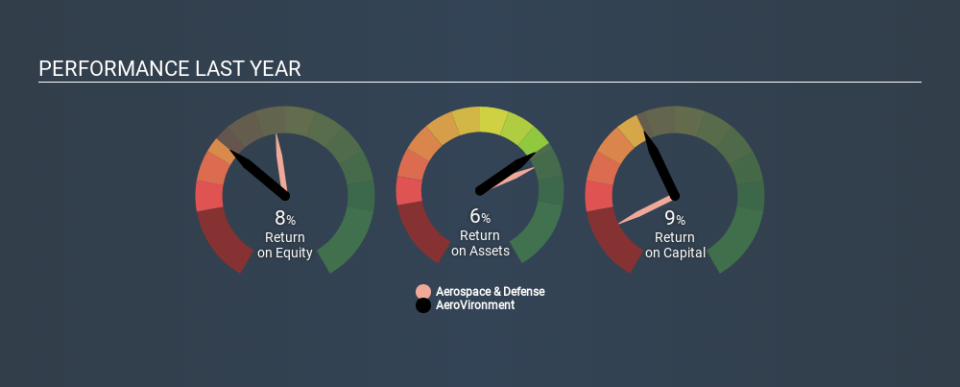Is AeroVironment, Inc. (NASDAQ:AVAV) Struggling With Its 8.9% Return On Capital Employed?

Today we'll look at AeroVironment, Inc. (NASDAQ:AVAV) and reflect on its potential as an investment. Specifically, we'll consider its Return On Capital Employed (ROCE), since that will give us an insight into how efficiently the business can generate profits from the capital it requires.
First of all, we'll work out how to calculate ROCE. Next, we'll compare it to others in its industry. And finally, we'll look at how its current liabilities are impacting its ROCE.
Understanding Return On Capital Employed (ROCE)
ROCE measures the amount of pre-tax profits a company can generate from the capital employed in its business. In general, businesses with a higher ROCE are usually better quality. In brief, it is a useful tool, but it is not without drawbacks. Renowned investment researcher Michael Mauboussin has suggested that a high ROCE can indicate that 'one dollar invested in the company generates value of more than one dollar'.
How Do You Calculate Return On Capital Employed?
Analysts use this formula to calculate return on capital employed:
Return on Capital Employed = Earnings Before Interest and Tax (EBIT) ÷ (Total Assets - Current Liabilities)
Or for AeroVironment:
0.089 = US$45m ÷ (US$544m - US$45m) (Based on the trailing twelve months to October 2019.)
Therefore, AeroVironment has an ROCE of 8.9%.
Check out our latest analysis for AeroVironment
Is AeroVironment's ROCE Good?
One way to assess ROCE is to compare similar companies. In this analysis, AeroVironment's ROCE appears meaningfully below the 11% average reported by the Aerospace & Defense industry. This performance could be negative if sustained, as it suggests the business may underperform its industry. Setting aside the industry comparison for now, AeroVironment's ROCE is mediocre in absolute terms, considering the risk of investing in stocks versus the safety of a bank account. It is possible that there are more rewarding investments out there.
AeroVironment has an ROCE of 8.9%, but it didn't have an ROCE 3 years ago, since it was unprofitable. That implies the business has been improving. You can see in the image below how AeroVironment's ROCE compares to its industry. Click to see more on past growth.
When considering ROCE, bear in mind that it reflects the past and does not necessarily predict the future. ROCE can be deceptive for cyclical businesses, as returns can look incredible in boom times, and terribly low in downturns. ROCE is only a point-in-time measure. Since the future is so important for investors, you should check out our free report on analyst forecasts for AeroVironment.
Do AeroVironment's Current Liabilities Skew Its ROCE?
Current liabilities include invoices, such as supplier payments, short-term debt, or a tax bill, that need to be paid within 12 months. The ROCE equation subtracts current liabilities from capital employed, so a company with a lot of current liabilities appears to have less capital employed, and a higher ROCE than otherwise. To counteract this, we check if a company has high current liabilities, relative to its total assets.
AeroVironment has total assets of US$544m and current liabilities of US$45m. As a result, its current liabilities are equal to approximately 8.2% of its total assets. AeroVironment reports few current liabilities, which have a negligible impact on its unremarkable ROCE.
What We Can Learn From AeroVironment's ROCE
Based on this information, AeroVironment appears to be a mediocre business. Of course, you might find a fantastic investment by looking at a few good candidates. So take a peek at this free list of companies with modest (or no) debt, trading on a P/E below 20.
If you are like me, then you will not want to miss this free list of growing companies that insiders are buying.
If you spot an error that warrants correction, please contact the editor at editorial-team@simplywallst.com. This article by Simply Wall St is general in nature. It does not constitute a recommendation to buy or sell any stock, and does not take account of your objectives, or your financial situation. Simply Wall St has no position in the stocks mentioned.
We aim to bring you long-term focused research analysis driven by fundamental data. Note that our analysis may not factor in the latest price-sensitive company announcements or qualitative material. Thank you for reading.

 Yahoo Finance
Yahoo Finance 
